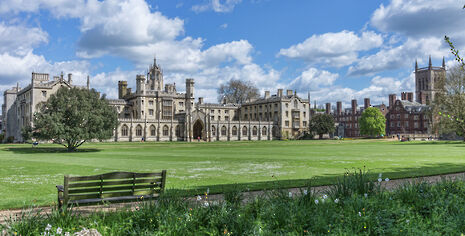St John’s bursary scheme should exist in every college
New grants to low-income St John’s students should be welcomed, but they could further increase inequality between colleges

As a response to the government cut of maintenance grants for lower income students, St John’s College has announced a major financial support initiative which will fund the living costs of students from low-income backgrounds starting in October 2016. Home and EU undergraduates studying at John’s with a household income of under £25,000 are now entitled to a non-repayable sum of £9570 per year to help with their living costs, in part provided by the existing programme of financial support offered by the University. The college estimates that the programme will cost them about £145,680 in the first year, which will be covered by a new fund of contributions from alumni.
At the same time, the college will launch a programme of summer bursaries, available to students whose household income is under the threshold of £66,154 to enable academic study and the pursuit of educational interests over the summer, without having to worry about earning money to cover living costs for the following year. This support is open to UK and EU students only, but could be extended to international students in the following years. However, this highlights the fact that colleges such as Trinity and John’s can offer a whole range of financial support to their students, while poorer colleges have no choice but to ask low-income students to deal with their loans themselves.
The initiative is great in enabling students from diverse backgrounds to have the same opportunities and benefits as their wealthier peers while studying in Cambridge, without worrying about how to pay back the student loan once they have graduated, or saving every penny shopping in Sainsbury’s while their course mates are indulging in dinner at Jamie Oliver’s. Spending the summer in exotic countries and carrying out ethnographic studies as opposed to working for four months in your local café is not only an invaluable enhancement of personal experience, it also means later job applications by students from low-income backgrounds can better compete with the better-off.
Additionally, John’s, a college seen by some to have a reputation of socially elitism, would surely benefit from a higher percentage of state-schooled children within their prestigious halls. The prospect of fully-funded living costs will likely attract a higher number of state school applicants in the future. Considering that the drop-out rate among students from low participation areas is 3.3 per cent compared to only 1.3 per cent for students from other areas, this initiative would perhaps aid not only in motivating more state-schooled students to apply to John’s, but also enable them financially to stay.
The Cambridge bursary scheme currently offers a maximum of £3,500 to students from low-income backgrounds, meaning students from St John’s will receive three times the amount of support every year than the average Cambridge student does. It can be expected, then, that even more students will choose to apply to the prestigious John’s now, a college already oversubscribed with 948 applications in 2016, compared to only 412 for Robinson and 318 for Murray Edwards. John’s already has the option to cherry-pick the brightest students out of the candidates, and it seems these financial incentives will widen the gap between applications to wealthy colleges which can better support their students compared to many of the poorer colleges.
Robinson, which admits only 47.4 per cent of their students from state schools, would equally benefit from the financial means of John’s to offer funds to less privileged students, as Emily Fishman, Robinson’s Access Officer explains:
“Robinson already has a lower number of direct applicants, compared to Peterhouse, Emma or Clare, for example. Robinson however would simply not be able to afford a scheme like John’s ... The risk is that Robinson’s already-low number of direct applicants would decline even further. Overall I think the idea is a good and a positive one, especially for deprived students, however the scheme needs to be one run by the university … [Otherwise,] it will create more competition and difficulty for smaller colleges.”
Extended to the whole university, this scheme would be useful in reducing disparities between colleges with different percentages of students from low-income backgrounds. I believe it would also help Cambridge to reach its targets for admitting more students from disadvantaged backgrounds. After the government scrapped bursaries for low-income families, it would be a positive step if Cambridge were to take up the initiative and allow low-income students to thrive in every college, not just St John’s. The programme would not only take a lot of financial worries from the shoulders of students having to deal with the ‘are you posh?’ question daily, but also send a strong message to applicants across the country and even Europe, who might never have considered applying to Cambridge otherwise.
While John’s is the only college with such a programme in place, some inequalities among the colleges will be fortified. Nonetheless it is better to have one college spearhead a much-needed initiative than to never start it at all.
 News / ‘Out of the Ordinary’ festival takes over Cambridge 26 August 2025
News / ‘Out of the Ordinary’ festival takes over Cambridge 26 August 2025 News / Government pulls £277M in funding for Cambridge sewage works relocation25 August 2025
News / Government pulls £277M in funding for Cambridge sewage works relocation25 August 2025 News / Tompkins Table 2025: Trinity widens gap on Christ’s19 August 2025
News / Tompkins Table 2025: Trinity widens gap on Christ’s19 August 2025 Comment / Who could possibly want more exams?25 August 2025
Comment / Who could possibly want more exams?25 August 2025 News / News in Brief: Brain breakthroughs, bouldering, and the ‘broligarchy’24 August 2025
News / News in Brief: Brain breakthroughs, bouldering, and the ‘broligarchy’24 August 2025








